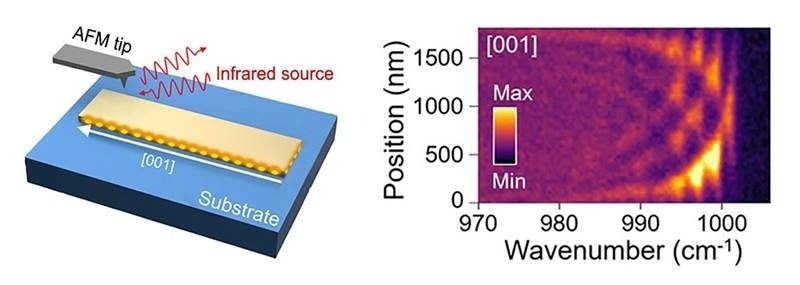Infrared light and electronics combined can create small, quick, and sensitive molecular sensing, imaging, and signaling devices. To fulfill the criteria for these functions, materials in the infrared spectrum must adhere to strict quality standards for their crystals. Now, researchers have developed a more effective method for creating superior crystals with strong infrared resonance.
 The tip of an atomic force microscope (AFM) focuses infrared (IR) light from an X-ray beamline onto a tiny spot, enabling researchers to detect the lattice vibrations of an ultrathin, ribbon-like nanocrystal (yellow). Image Credit: Lawrence Berkeley National Laboratory and Stanford University
The tip of an atomic force microscope (AFM) focuses infrared (IR) light from an X-ray beamline onto a tiny spot, enabling researchers to detect the lattice vibrations of an ultrathin, ribbon-like nanocrystal (yellow). Image Credit: Lawrence Berkeley National Laboratory and Stanford University
They used a special infrared probe to test these ribbon-shaped nanocrystals, or “nanoribbons.” The measured quality of the nanoribbons is the highest for these materials that have been reported thus far. Because of this characteristic, the crystals are extremely promising for application in high-end infrared electronics.
The Impact
The technique known as flame vapor deposition (FVD) was employed by the researchers to create the nanoribbons. FVD is scalable, affordable, and quick. It is an improvement over an earlier technique that peeled material layers off a bulk material using adhesive tape. Additionally, FVD eliminates the need for additional treatments that could contaminate and harm the crystals, lowering their quality.
The incredibly smooth, parallel edges of the nanoribbons made using FVD serve as reflecting surfaces. Because of this, standing vibrational waves can naturally resonantly act via the nanoribbons. The technique makes it possible to produce high-quality infrared resonators for research and development in a direct, expedient, and scalable way.
Summary
Molybdenum oxide (MoO3) nanoribbons, a material with features that could be beneficial for adapting its resonances to infrared light wavelengths, were grown by researchers using FVD. They varied the temperature, time, and molybdenum content to manipulate the synthesized samples’ sizes and shapes.
The researchers utilized Synchrotron Infrared Nano-Spectroscopy (SINS) at the Advanced Light Source, a Department of Energy (DOE) Office of Science user facility at Lawrence Berkeley National Laboratory, to assess the quality of these nanoresonators. SINS focuses beams of infrared light from synchrotron radiation using the tip of an atomic force microscope to a spot size smaller than the wavelength of the infrared light.
Resonance modes above the 10th order are detected in the resulting resonance maps, which fully define the ultra-broadband infrared response of MoO3 nanoribbons manufactured by FVD for the first time with great spatial and spectral resolution. The outstanding crystal quality of the manufactured nanoribbons is amply demonstrated by the quality factors, which are a measure of the resonances’ sharpness.
Funding
Advanced Light Source, a DOE Office of Science user facility, provided resources for this study. The National Science Foundation, the Air Force Office of Scientific Research, the Packard Fellowship Foundation, the DOE Office of Science, the Basic Energy Sciences Energy Frontier Research Center program, and the National Defense Science and Engineering Graduate Fellowship Program were among the additional funding sources.
Journal Reference:
Yu, S.-J., et al. (2023) Ultrahigh-Quality Infrared Polaritonic Resonators Based on Bottom-Up-Synthesized van der Waals Nanoribbons. ACS Nano. doi:10.1021/acsnano.1c10489